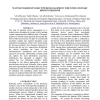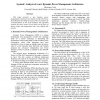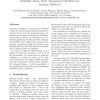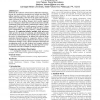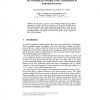TODAES
2008
14 years 3 months ago
2008
The goal of dynamic power management is to reduce power dissipation in system level by putting system components into different states. This paper proposes a wavelet based approac...
AC
2005
Springer
14 years 3 months ago
2005
Springer
Reducing power consumption has become a major challenge in the design and operation of today's computer systems. This chapter describes different techniques addressing this c...
CORR
2007
Springer
14 years 3 months ago
2007
Springer
This paper presents a new dynamic power management architecture of a System on Chip. The Power State Machine describing the status of the core follows the recommendations of the A...
EMSOFT
2008
Springer
14 years 4 months ago
2008
Springer
Dynamic Voltage Scaling (DVS) and Dynamic Power Management (DPM) are two popular techniques commonly employed to save energy in real-time embedded systems. DVS policies aim at red...
ECRTS
2010
IEEE
14 years 4 months ago
2010
IEEE
Energy conservation is an important issue in the design of embedded systems. Dynamic Voltage Scaling (DVS) and Dynamic Power Management (DPM) are two widely used techniques for sav...
DAGSTUHL
2006
14 years 5 months ago
2006
Long-term reliability of processors in embedded systems is experiencing growing attention since decreasing feature sizes and increasing power consumption have a negative influence...
GLVLSI
1999
IEEE
14 years 8 months ago
1999
IEEE
Dynamic power management can be effective for designing low-power systems. In many systems, requests are clustered into sessions. This paper proposes an adaptive algorithm that ca...
DATE
1999
IEEE
14 years 8 months ago
1999
IEEE
Dynamic Power Management is a design methodology aiming at reducing power consumption of electronic systems, by performing selective shutdown of the idle system resources. The eff...
ISLPED
2003
ACM
14 years 9 months ago
2003
ACM
Enabled by the continuous advancement in fabrication technology, present day synchronous microprocessors include more than 100 million transistors and have clock speeds well in ex...
ICESS
2004
Springer
14 years 9 months ago
2004
Springer
In this paper we present a new modeling technique using software engineering tool Flow Model for modeling and solving the Dynamic Power Management (DPM) with complex behavioral cha...
